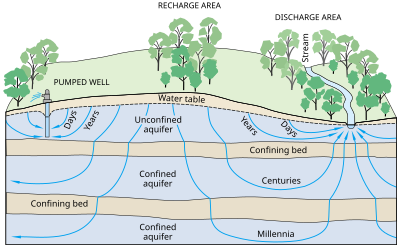
Back Acuifero AN طبقة المياه الجوفية Arabic آکیفر AZB Водоносен хоризонт Bulgarian ভূগর্ভস্থ সিক্ত শিলাস্তর Bengali/Bangla Aqüífer Catalan ئاوھەڵگر CKB Zvodeň Czech Grundvandsmagasin Danish Grundwasserleiter German

An aquifer is an underground layer of water-bearing material, consisting of permeable or fractured rock, or of unconsolidated materials (gravel, sand, or silt). Aquifers vary greatly in their characteristics. The study of water flow in aquifers and the characterization of aquifers is called hydrogeology. Related terms include aquitard, which is a bed of low permeability along an aquifer, and aquiclude (or aquifuge), which is a solid, impermeable area underlying or overlying an aquifer, the pressure of which could lead to the formation of a confined aquifer. The classification of aquifers is as follows: Saturated versus unsaturated; aquifers versus aquitards; confined versus unconfined; isotropic versus anisotropic; porous, karst, or fractured; transboundary aquifer.
Groundwater from aquifers can be sustainably harvested by humans through the use of qanats leading to a well.[1] This groundwater is a major source of fresh water for many regions, however can present a number of challenges such as overdrafting (extracting groundwater beyond the equilibrium yield of the aquifer), groundwater-related subsidence of land, and the salinization or pollution of the groundwater.
- ^ Walker, Kira (2022). "Ancient systems keep water flowing". Nature Middle East. Nature. doi:10.1038/nmiddleeast.2022.72. S2CID 253486495. Retrieved 10 July 2023.